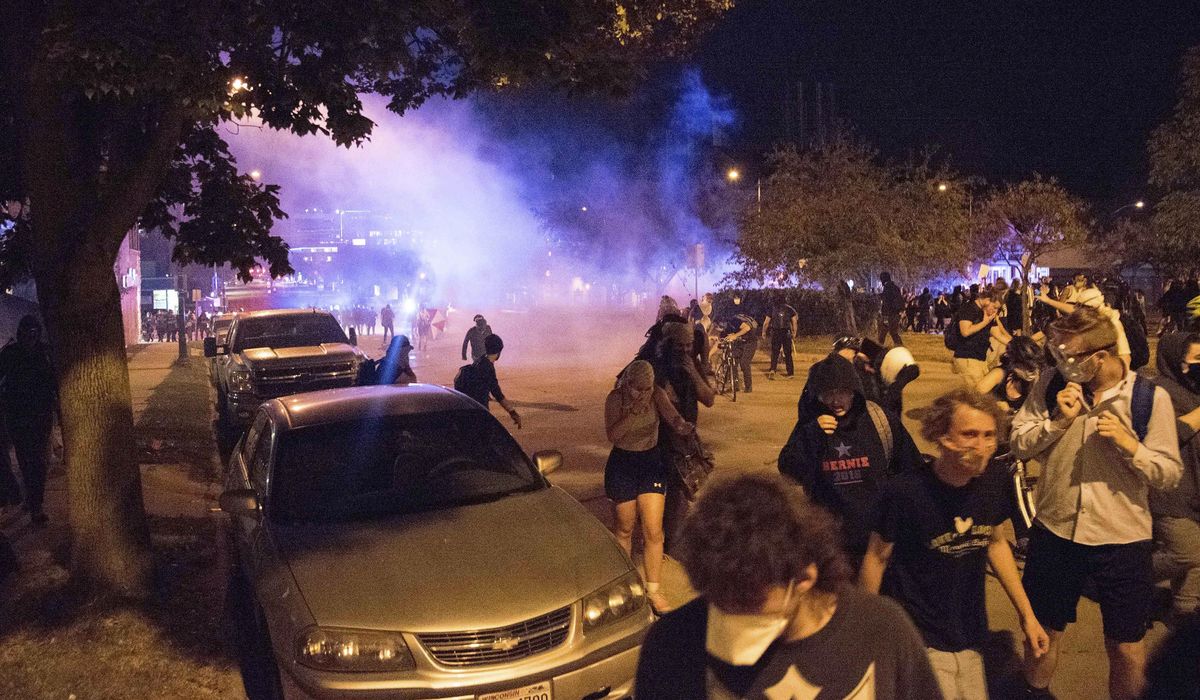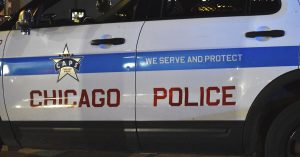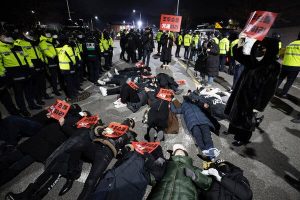MADISON, Wis. (AP) – At least 1,500 young people gathered on Madison, Wisconsin’s Mifflin Street in April 1973 for a block party. People drank beer, smoked weed and tossed Frisbees in a neighborhood near the University of Wisconsin-Madison campus.
Police officers observed the party from a distance, greeting attendees and directing traffic away from the event. They didn’t wear police caps, nor did they make arrests. The Saturday unfolded peacefully, in stark contrast to Mifflin Street parties of the past.
The annual event began in 1969 as a dance and protest of the Vietnam War, erupting that year into a weekend of unrest that injured dozens. Officers responded to a noise complaint and began arresting people for minor infractions.
The police action spurred people in the crowd to toss rocks at the officers. As tension escalated, police raided homes, launched tear gas and rammed barricades with squad cars. Madison officials would view subsequent Mifflin Street parties as nuisances in need of quashing, refusing to issue permits to close streets.
In 1970, Vietnam War protests escalated, culminating in the deadly bombing of UW-Madison’s Sterling Hall. When the Mifflin Street block party rolled around in 1971, then-Mayor William Dyke dispatched a riot squad to control the crowd.
Enter David Couper. Appointed police chief in 1972 at age 35, he sought to change the narrative surrounding the party – and his department. The city permitted the event, and it “went off without a hitch,” Couper recalled. It would continue to do so throughout his 21-year tenure.
That was due to a strategy that would forge the department’s reputation for overseeing protests that stayed peaceful. Couper’s philosophy of respecting free speech and assembly offered a blueprint for police to ditch militarized crowd control tactics that, decades of research shows, more often escalate violence rather than prevent it.
“Why does it have to be the police versus people who want to protest? Why can’t police be there to facilitate protest?” Couper told Wisconsin Watch.
___
The nonprofit news outlet Wisconsin Watch provided this article to The Associated Press through a collaboration with Institute for Nonprofit News.
___
Those questions are resonating in a tumultuous 2020. Several Wisconsin cities – including Kenosha, Madison, Milwaukee and Wauwatosa – saw police don body armor and fire crowd control weapons during protests that, at times, turned destructive. The events unfolded during a summer of nationwide unrest following police killings and shootings of Black people.
The national spotlight has shined most brightly on Kenosha, where a police officer during an Aug. 23 domestic disturbance shot Jacob Blake, a 29-year-old Black man, in the back seven times, sparking consecutive nights of protests.
Violence and property damage rapidly escalated in the hours following the shooting after law enforcement began firing lung-damaging tear gas and rubber bullets into the crowds. Officers continued such tactics during subsequent nights, including on Aug. 25 – when 17-year-old Kyle Rittenhouse fatally shot two people and injured another after responding to calls for vigilantes to protect property in Kenosha.
The Madison model of dialogue may not have prevented the mayhem in Kenosha, because police lacked training and did not first do enough to gain Black residents’ trust in the deeply segregated city, said Selika Ducksworth-Lawton, a history professor at the UW-Eau Claire with expertise in civil rights and the military.
The Kenosha Police Department did not respond to repeated requests for comment about tactics used with protesters. The Kenosha County Sheriff’s Office declined to respond to emailed questions.
Law enforcement’s response in Kenosha – including the early use of armored vehicles and the decision to arrest protesters en masse for curfew violations – ran counter to established best practices.
“History has taught us that the premature or ill-advised use of force against protesters, particularly the use of riot control techniques, often amplifies conflict with protesters and can instigate violence,” Edward Maguire, a professor of criminal justice at Arizona State University, wrote in a 2015 study.
The pillars of Couper’s philosophy remain embedded in the Madison Police Department’s standard operating procedure. “We protect people first and property second,” the document says.
But after Madison this summer saw its own smashed storefronts and chemical clouds during confrontations between police and protesters – interspersed between weeks of peaceful demonstrations – Couper is among those questioning whether his former department retains public trust.
“If you start using tear gas or pepper spray, you’ve pretty well lost things,” said Couper, now an Episcopal priest and peace activist. “People are going to remember that for years.”
Couper came of age in policing during the turbulent 1960s, forging relationships with Minneapolis-area residents as he patrolled by foot. Racial unrest swept cities nationwide during the summer of 1967, with Detroit and Newark, New Jersey seeing the most violent clashes between police and Black residents. Milwaukee, where decades of racist housing policies and police brutality fueled outrage in Black-majority neighborhoods, saw an uprising that resulted in four deaths and 100 people injured.
President Lyndon Johnson’s Kerner Commission would later conclude that police action sparked half of the 24 nationwide uprisings probed in detail. It called for police departments to “eliminate abrasive practices” and recommended massive investments in housing and economic programs to bolster quality of life for Black residents. A previous Johnson commission called on police to more carefully plan their response to protests and engage with organizers beforehand.
“Police must not react to disorder in the course of demonstrations too quickly or with too much force,” said that commission’s 1967 report.
Couper said he “figured (police) had to do something different” after Martin Luther King Jr. was assassinated in Memphis, Tennessee in 1968.
As Couper policed in Minnesota, Madison saw protests against the Vietnam War and other targets, including police brutality and racism. Protesters held sit-ins, marched and damaged property. Police often responded with billy clubs and tear gas.
Decades later, Ducksworth-Lawton said evidence is only growing that militarized policing only escalates violence between crowds and police.
“The problem is that the ‘us versus them’ militarized occupation mentality creates anxiety and nervousness and (police) don’t know how to de-escalate,” she said.
Officers are more likely to keep crowds peaceful by targeting those whose actions are endangering the public, while continuing to protect the rights of peaceful protesters, ASU’s Maguire wrote in 2015.
Maguire pointed to a “graded response” as a way for police to limit tension while keeping themselves safe. That involves staging tactical tools nearby but out of sight for use if needed.
“If they are visible to the crowd, instead of enhancing officer safety, they may place officers at greater risk by escalating matters,” he wrote.
Couper saw a trust gap between Madison residents and police when he became one of the youngest police chiefs in city history in 1972. He began meeting with organizers ahead of protests and etching respect for the First Amendment in department policy. Couper sought to instill a “peace officer” mindset.
His ideas initially elicited grumbles from some veteran officers, according to news reports from time. But Couper generally received high marks from city officials and younger officers.
When Couper retired in 1993, the U.S. Department of Justice studied his department’s work in creating an experimental district in which officers made decisions in teams. Officers reported better attitudes and fewer residents perceived crime as a problem in the community.
But many U.S. police departments beginning in the 1990s embraced more militarized tactics.
Couper includes Madison in that camp, pointing to its participation in the federal 1033 Program, allowing state and local departments to access Department of Defense property. That mostly includes “general” items, such as furniture and computers. But the program also loans out weapons and other items associated with war, called “controlled property.”
Wisconsin police departments, sheriff offices and other agencies have accessed more than $42 million in controlled property since 1994, federal data show.
Unrest in Madison this spring reignited emotional conversations about how local police respond to protests.
On three consecutive nights beginning May 30, Madison police clad in riot gear fired tear gas, pepper spray and sponge projectiles to disperse people who took to the streets after Minneapolis police killed George Floyd.
After thousands of Madison protesters peacefully marched during daytime protests, smaller groups smashed vehicles and broke into stores. Madison police said officers fired crowd control weapons only after people began damaging property and throwing rocks. But the chemical clouds also stung peaceful protesters and bystanders.
“Nothing turned violent until police instigated the violence,” Nick Harrison, a 27-year-old Madison resident who protested one night, told Wisconsin Watch. “I saw a strong sense of community until the police showed up, dressed for war.”
Acting Madison Police Chief Vic Wahl said officers deployed tear gas only because some people “were intent on creating and engaging violence.”
“We have an obligation to intervene,” Wahl said in July.
The Quattrone Center for the Fair Administration of Justice is now examining the police response at Wahl’s request.
Wahl said he continues to follow Couper’s model. His department communicated with protesters ahead of many marches throughout the summer, he said. Madison officers shifted to a hands-off approach following the incidents of late May and early June, and downtown stayed peaceful for weeks.
But vandalism and violence returned in late June when a group of protesters tore down two statues near the state Capitol and assaulted state Sen. Tim Carpenter, D-Milwaukee. Officers used pepper spray to thwart a break-in of the Capitol.
Republican state lawmakers scolded Madison’s leaders for failing to prevent the episode.
The Madison Common Council in October approved a measure requiring MPD to study its use of tear gas. The council will review the findings before weighing whether to ban its use.
“It’s not a healthy substance,” said Ald. Patrick Heck, one resolution sponsor. “It was quite problematic – not just for the people who were targeted by the tear gas but people standing by.”
Another new ordinance limits the police department’s use of the 1033 Program.
Wahl said he wants to improve his department but opposes limiting its crowd control arsenal and worries about a “frenzy right now about policing.”
Couper is sure of one thing as he examines policing from the outside: “Things have got to change.”



















